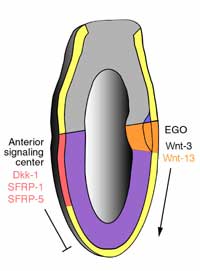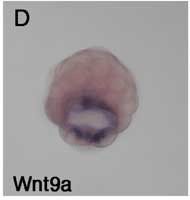Role of Wnts during mouse development
 It
was shown that Wnt3 mutant embryos lack a primitive streak and
therefore no mesoderm is formed during gastrulation. The anterior
visceral endoderm (aVE), a cell layer
underlying the future head region and located in the embryo on
the side opposite to the primitive streak, is, however, properly
located and correctly patterned. Moreover, a mutation in the
beta-Catenin gene (Catnb), a cellular effector of the Wnt pathway,
leads to a lack of mesoderm, confirming the role of Wnt in axis
formation.
It
was shown that Wnt3 mutant embryos lack a primitive streak and
therefore no mesoderm is formed during gastrulation. The anterior
visceral endoderm (aVE), a cell layer
underlying the future head region and located in the embryo on
the side opposite to the primitive streak, is, however, properly
located and correctly patterned. Moreover, a mutation in the
beta-Catenin gene (Catnb), a cellular effector of the Wnt pathway,
leads to a lack of mesoderm, confirming the role of Wnt in axis
formation.
It has also been shown that Dkk1, a Wnt antagonist, is expressed
in the aVE region of the gastrula underlying the future head.
However, the analysis of the Dkk1 mutant phenotype shows that
it is not required for the formation of the head at the early
gastrula stage but that it is required at a later stage. In contrast,
in the zebrafish, the tlc Wnt antagonist has been shown to be
necessary for the initial patterning of
the anterior brain. Moreover, another Wnt
antagonist, Sfrp5 is also expressed in the aVE.
These gastrula organizing activities are reflected in the expression
pattern and role of Wnt signals in the primitive streak and of
Wnt antagonists in the aVE (reviewed in Leyns and Kemp, 2004).
As gastrulation proceeds and organs start to be formed, other
Wnt genes begin to be expressed in specific domains and several
have been identified to play
critical roles during development. The inactivation of Wnt1, Wnt2, Wnt3a,
Wnt4, Wnt5a, Wnt7a, Wnt7b and Wnt11 lead to embryonic phenotypes
(see phenotype overview
and references on the Wnt
gene Homepage).
A serious difficulty encountered in the study of the functions of the Wnt
genes is their potential redundancy since various Wnts can bind to the same
Frizzled
receptor and trigger the activation of the pathway. This has been shown in
a study of mouse embryos double mutant for Wnt1 and Wnt3a.
Therefore, the role of some Wnts or of their antagonists during mouse development
may not be revealed by loss-of-function experiments.
Research: gene expression studies
To
identify the Wnt genes and their antagonists that may be involved
in the antero-posterior patterning of the gastrula and
in the
formation
of
the
blastocyst,
we analyzed
the expression level of all nineteen Wnt genes and eleven potential antagonists
by reverse transcription real-time PCR (qRT-PCR) in the mouse blastocyst,
pre-gastrula, gastrula and neurula stages. This approach allowed
us to carry out a semi-quantitative study with a high sensitivity
of complete gene families involved in Wnt
signaling.
The most interesting profiles were further investigated by whole-mount ISH
to reveal new expression domains for Wnt1, Wnt2b, Wnt3a, Wnt4, Wnt6, Wnt7b,
Wnt9a, Wnt10b, Sfrp1, Sfrp5 and Dkk1.
Wnts in the mouse blastocyst
 To test the possibility that
Wnts are involved in the maintenance of pluripotency of blastocyst
cells,
we
analyzed
the mRNA levels
of the Wnt and antagonist genes and the expression domains
of the selected candidate genes by ISH on blastocyst embryos.
We have shown that the highest expression
level for the Wnt3a, -6, -7b, -9a and -10b genes was in the
blastocyst.
To test the possibility that
Wnts are involved in the maintenance of pluripotency of blastocyst
cells,
we
analyzed
the mRNA levels
of the Wnt and antagonist genes and the expression domains
of the selected candidate genes by ISH on blastocyst embryos.
We have shown that the highest expression
level for the Wnt3a, -6, -7b, -9a and -10b genes was in the
blastocyst.
We found that Wnt3a, Wnt6, Wnt7b and Wnt10b are expressed
in the entire blastocyst but that Wnt6 expression is stronger
in the cells surrounding the blastocoel cavity. We also found
that Wnt1 and Sfrp1 are predominantly expressed in the inner
cell mass of the blastocyst. The expression of the Wnt1,
-3a, -6 and -7b genes, known to trigger the Wnt canonical
pathway
in which beta-Catenin is a key player, may provide autocrine
and paracrine Wnt signals to the inner cell mass cells. Neither
the gene inactivation of Wnt1 nor that of Wnt3a or Wnt7b
leads to pre-implantation defects, suggesting that these
Wnts may
play redundant roles during patterning of the pre-implantation
embryo.
Wnts in the mouse gastrula
 By whole-mount ISH followed by sectioning,
we found that the Wnt2b gene starts to be expressed before
the appearance of the primitive streak in the epiblast and
underlying visceral endoderm on one side of the embryo, the
presumptive posterior side. During the formation of the primitive
streak and the rest of gastrulation, Wnt2b is expressed in
the primitive streak, the newly formed mesoderm and the underlying
endoderm.
By whole-mount ISH followed by sectioning,
we found that the Wnt2b gene starts to be expressed before
the appearance of the primitive streak in the epiblast and
underlying visceral endoderm on one side of the embryo, the
presumptive posterior side. During the formation of the primitive
streak and the rest of gastrulation, Wnt2b is expressed in
the primitive streak, the newly formed mesoderm and the underlying
endoderm.
We also showed that at the 5.5dpc stage,
the aVE expresses three secreted Wnt antagonists (Sfrp1, Sfrp5
and Dkk1) in partially overlapping domains suggesting a possible
redundant function during head induction and patterning.We
propose that Sfrp1, Sfrp5 and Dkk1 are responsible for the
inhibition of Wnt signaling at the anterior side of the embryo
therefore allowing the formation of the head region. The
expression
of these Wnt antagonists in overlapping domains suggests
that they may be redundant which may explain the lack of phenotype
in Dkk1 mutant embryos during initiation of head formation
even if at later stages the Dkk1 mutation is responsible
for
missing head structures.
Up